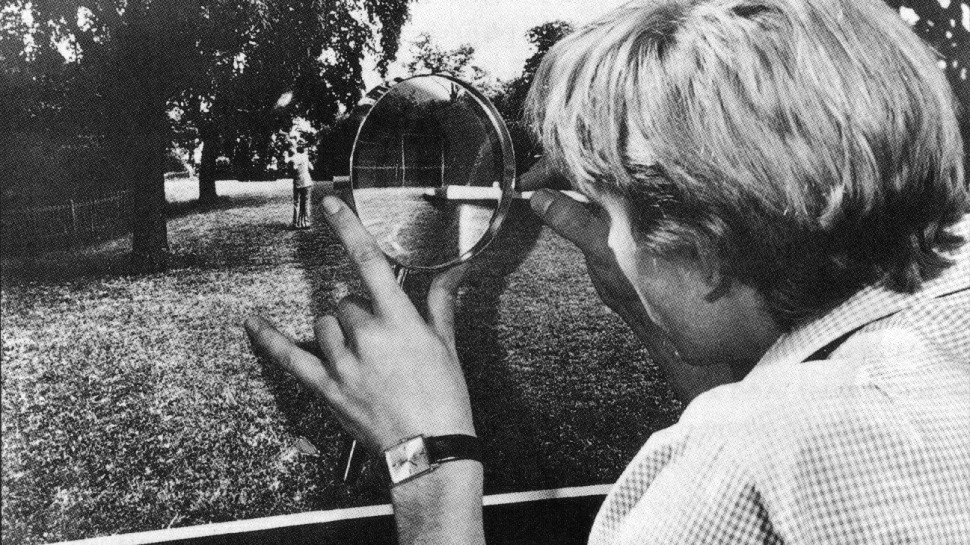


The Mysteries of Michelangelo Antonioni
Together with Fellini, Bergman and Kurosawa, Michelangelo Antonioni (1912 – 2007) is credited with defining the modern art film. And yet Antonioni’s cinema is also recognized today for defying any easy categorization, with his films ultimately seeming to belong to their own distinctive genre. Indeed, the difficulty of precisely describing their category is itself the very quintessence of Antonioni’s films. Among the most-cited contributions of Antonioni’s cinema are their striking descriptions of that unique strain of post-boom ennui everywhere apparent in the transformed life and leisure habits of the Italian middle and upper classes. Detecting profound technological, political and psychological shifts at work in post-WWII Italy, Antonioni set out to explore the ambiguities of a suddenly alienated and dislocated Italy, not simply through his oblique style of narrative and characters, nor through any overt political messaging, but instead by tearing asunder the traditional boundaries of cinematic narrative in order to explore an ever shifting internal landscape expressed through architecture, urban space and the sculptural, shaping presence of objects, shapes and emotions invented by camera movement and depth of focus.
Antonioni deftly manipulates the quieter, indirect edges of cinematic structure, often so discretely that his existential puzzles are felt before they can be intellectualized. The negative space is as prominent as the positive, silence as loud as noise, absence as palpable as presence, and passivity as driving a force as direct action. Transgressing unspoken cinematic laws, Antonioni frequently focuses on female protagonists while refusing to sentimentalize or morally judge his characters and placing them on equal footing with the other elements within his total dynamic system, like sounds or set pieces. And he violates spoken rules with unconventional cutting techniques, fractured spatial and temporal continuity, and a camera that insistently lingers in melancholy pauses, long after the actors depart, as if drifting just behind an equally distracted, dissipating narrative. Leaving questions unanswered and plot points irresolute, dispensing with exposition, suspense, sentimentality and other cinematic security blankets, Antonioni releases the viewer into a gorgeous, densely layered fog to contemplate and wrestle with his characters’ imprecise quandaries and endless possibilities. Culminating in tour de force endings that often reframe the narrative in a daring, parting act of deconstruction, Antonioni’s rigorously formal, yet open compositions allow his great, unwieldy questions to spill over into the world outside the cinema and outside of time.
Born into a middle-class family in the northern Italian town of Ferrara, Antonioni studied economics at the University of Bologna where he also co-founded the university’s theatrical troupe. While dedicating himself to painting, writing film reviews, working in financial positions and in different capacities on film productions, Antonioni suffered a few false starts before expressing his unique directorial vision and voice in his first realized short film, Gente del Po, a moving portrait of fisherman in the misty Po Valley where he was raised. Uncomfortable with the neo-realist thrust of Italian cinema, Antonioni directed a series of eccentric and oblique documentary shorts that, in retrospect, reveal his desire to investigate the psyche’s mysterious interiors. In his first fictional feature, Story of a Love Affair, Antonioni immediately subtly challenged traditional plot and audience expectation in ways that anticipate the formal and emotional expressionist dynamic that would fully flower within the groundbreaking L’Avventura.
Reversing its raucous 1960 premiere to an infuriated Cannes audience, L’avventura was rapturously lauded by fellow artists and filmmakers and awarded a special Jury Prize “for its remarkable contribution toward the search for a new cinematic language.” It also presented the controlled ambivalence of Monica Vitti, who would become his partner, muse and psychological constant throughout his famed trilogy of L’avventura, La notte and L’eclisse in addition to the exquisite Red Desert, a film that marked another significant shift toward expressive color, male leads and working with soft focus and faster cuts. After the phenomenal commercial success of the MGM-produced Blow-up, Antonioni was devastated by the anti-climactic box office disaster of Zabriskie Point andreturned to documentary. Invited to make Chung Kuo China by the Chinese government, Antonioni delivered a mesmerizing yet unsentimental four-hour tour of China which was vehemently rejected by its solicitors. A few years later, Antonioni returned to fictional form in his last masterpiece, The Passenger, an enigmatic fable of vaporous identity that offers a bold companion piece to L’Avventura. Aside from the thematically retrospective Identification of a Woman and a period film made for television The Mystery of Oberwald in which he conducted unusual experiments with color and video, Antonioni closed out his career with mostly short films, many of which were made after he suffered a stroke in 1985.
Tremendously influential yet largely taken for granted, Antonioni made difficult, abstract cinema mainstream. Embracing an anarchic geometry, Antonioni turned the architecture of narrative filmmaking inside-out in the most eloquent way possible, with many of his iconic scenes eternally preserved in the depths of the cinema’s psyche. Observing modern maladies without judgment – sexism, dissolution of family and tradition, ecological/technological quandaries and the eternal questions of our place in the cosmos – Antonioni’s prescience continues to resonate deeply as we find our way in the quickly moving fog.
Upon his centennial celebration, the Harvard Film Archive is proud to present an extensive retrospective of the feature-length and short masterworks of the incomparable Michelangelo Antonioni. — Brittany Gravely



















